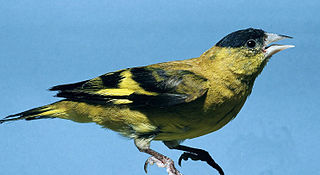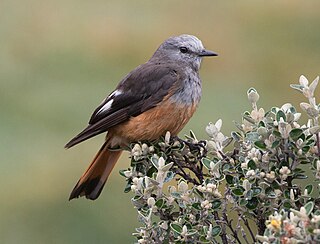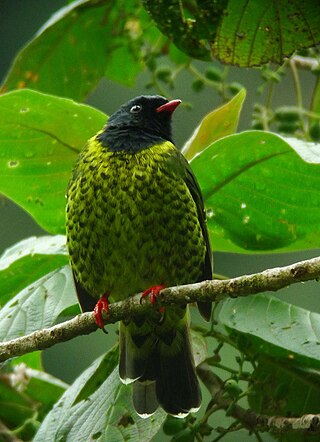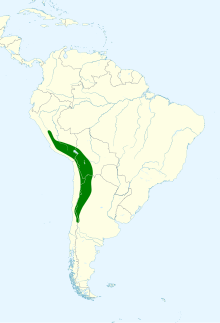
The Eurasian siskin is a small passerine bird in the finch family Fringillidae. It is also called the European siskin, common siskin or just siskin. Other (archaic) names include black-headed goldfinch, barley bird and aberdevine. It is very common throughout Europe and Eurosiberia. It is found in forested areas, both coniferous and mixed woodland where it feeds on seeds of all kinds, especially of alder and conifers.

The pine siskin is a North American bird in the finch family. It is a migratory bird with an extremely sporadic winter range.

The red siskin is a small endangered finch.

The yellow-bellied siskin is a small passerine bird in the finch family Fringillidae. It breeds from Costa Rica south to southern Ecuador, central Bolivia and the highlands of northwestern Venezuela.

The hooded siskin is a small passerine bird in the finch family (Fringillidae), native to South America. It belongs to the putative clade of neotropical siskins in the genus Spinus sensu lato.

The black-chinned siskin is a species of finch in the family Fringillidae. Found in Argentina, Chile and the Falkland Islands, its natural habitats are temperate forests and heavily degraded former forest.

The thick-billed siskin is a species of finch in the family Fringillidae. Found in Argentina, Bolivia, Chile, and Peru, its natural habitats are subtropical or tropical moist montane forests and subtropical or tropical high-altitude shrubland.

The olivaceous siskin is a species of finch in the family Fringillidae. It is found in Bolivia, Ecuador, and Peru, where its natural habitats are subtropical or tropical moist montane forests and heavily degraded former forest.

The saffron siskin is a species of finch in the family Fringillidae. It is found in Ecuador and Peru. Its natural habitats are subtropical or tropical dry forests, subtropical or tropical dry shrubland, and urban areas. It is threatened by habitat destruction and the IUCN has assessed it as being a "least concern species".

The Andean siskin is a species of finch in the family Fringillidae. It is found in Colombia, Ecuador, and Venezuela. Its natural habitats are subtropical or tropical moist montane forests, subtropical or tropical high-altitude shrubland, subtropical or tropical high-altitude grassland, and heavily degraded former forest.

The yellow-rumped siskin is a species of finch in the family Fringillidae. It is found in Argentina, Bolivia, Chile, and Peru. Its natural habitats are subtropical or tropical moist montane forests and subtropical or tropical high-altitude shrubland.

The yellow-faced siskin is a species of finch in the family Fringillidae. It is found in Brazil and Venezuela. Its natural habitats are subtropical or tropical moist mountains, subtropical or tropical dry shrubland, arable land, plantations, and urban areas.

The red-rumped bush tyrant is a species of bird in the family Tyrannidae. It is found in Bolivia, Colombia, Ecuador, and Peru. Its natural habitats are subtropical or tropical moist montane forests and subtropical or tropical high-altitude grassland.

The red pileated finch, also known as the red-crested finch, is a species of bird in the family Thraupidae. It is found in Argentina, Bolivia, Brazil, Ecuador, French Guiana, Guyana, Paraguay, Peru, on the eastern side of the Andes. Its natural habitats are subtropical or tropical dry forests, subtropical or tropical moist lowland forests, subtropical or tropical dry shrubland, and heavily degraded former forest. This is a common species, and the International Union for Conservation of Nature has rated its conservation status as "least concern".

The tawny-breasted myiobius or tawny-breasted flycatcher is a species of passerine bird in the family Tityridae. It is found in Bolivia, Colombia, Ecuador, Panama, Peru, and Venezuela. Its natural habitat is subtropical or tropical moist montane forests.

The band-tailed fruiteater is a species of bird in the family Cotingidae. It is found at high altitudes in the subtropical and tropical moist montane forests of Bolivia and Peru. It is a plump green bird with chevron-shaped markings on the flanks and a tail with a black band and white tip. Males have a black head and bib and a narrow yellow collar, while females lack these features. Both sexes have red beaks and legs. This is a relatively common species with a wide range, and the International Union for Conservation of Nature has rated its conservation status as being "least concern".

The dusky-green oropendola is a species of bird in the family Icteridae. It is found on the eastern slope of the Andes in Bolivia and Peru. Its natural habitats are subtropical or tropical moist montane forests and heavily degraded former forest.

The bright-rumped yellow finch is a species of bird in the family Thraupidae. It is found in the Puna grassland: Peru, Bolivia and northern Chile and Argentina. Its natural habitats are subtropical or tropical high-altitude grassland and heavily degraded former forest.

The white-rumped swallow is a species of bird in the family Hirundinidae. First described and given its binomial name by French ornithologist Louis Pierre Vieillot in 1817, it was for many years considered a subspecies of the Chilean swallow. The species is monotypic with no known population variations. It has a white supraloral streak, or streak above its lores, which can be used to differentiate it from the Chilean swallow. The lores, ear coverts, tail, and wings are black, with white tips on the inner secondaries, tertials, and greater coverts of the wings. The rest of the upperparts are a glossy blue. Its underparts and underwing-coverts are white, in addition to the rump, as the name suggests. The sexes are similar, and the juvenile is duller and browner with a dusky breast.






















